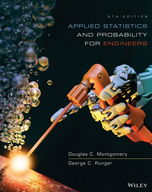Solution Found!
Solved: The analysis of results from a leaf transmutation
Chapter 3, Problem 147E(choose chapter or problem)
The analysis of results from a leaf transmutation experiment (turning a leaf into a petal) is summarized by the type of transformation completed:
\(\begin{array}{|lccc|} \hline & & {\begin{array}{c} \text { Total Textural } \\ \text { Transformation } \end{array}} \\ \hline & & \text { Yes } & \text { No } \\ \text { Total Color } & \text { Yes } & 243 & 26 \\ \text { Transformation } & \text { No } & 13 & 18 \\ \hline \end{array}\)
A naturalist randomly selects three leaves from this set without replacement. Determine the following probabilities.
(a) Exactly one has undergone both types of transformations.
(b) At least one has undergone both transformations.
(c) Exactly one has undergone one but not both transformations.
(d) At least one has undergone at least one transformation.
Questions & Answers
QUESTION:
The analysis of results from a leaf transmutation experiment (turning a leaf into a petal) is summarized by the type of transformation completed:
\(\begin{array}{|lccc|} \hline & & {\begin{array}{c} \text { Total Textural } \\ \text { Transformation } \end{array}} \\ \hline & & \text { Yes } & \text { No } \\ \text { Total Color } & \text { Yes } & 243 & 26 \\ \text { Transformation } & \text { No } & 13 & 18 \\ \hline \end{array}\)
A naturalist randomly selects three leaves from this set without replacement. Determine the following probabilities.
(a) Exactly one has undergone both types of transformations.
(b) At least one has undergone both transformations.
(c) Exactly one has undergone one but not both transformations.
(d) At least one has undergone at least one transformation.
ANSWER:Step 1 of 4
Given the leaf transformation experiment table is given below.
\(\begin{array}{|lccc|} \hline & & {\begin{array}{c} \text { Total Textural } \\ \text { Transformation } \end{array}} \\ \hline & & \text { Yes } & \text { No } \\ \text { Total Color } & \text { Yes } & 243 & 26 \\ \text { Transformation } & \text { No } & 13 & 18 \\ \hline \end{array}\)
Here, N, n and K is
\(\mathrm{N}=243+26+13+18=300\)
The sample size n is randomly selected.
So n= 3.
K= 243 (both type of transformations)
Then the probability mass function is
\(\mathrm{P}(\mathrm{X}=\mathrm{x})=\frac{\left(\begin{array}{l} K \\ 2 \end{array}\right)\left(\begin{array}{c} N-K \\ n-x^{\prime} \end{array}\right)}{\left(\begin{array}{l} N \\ n \end{array}\right)}\)
Where, N=300, n=3 and K=243.
Our goal is:
a). We need to find the probability that exactly one leaf has undergone both types of transformations.
b). We need to find the probability that at least one leaf has undergone both types of transformations.
c). We need to find the probability that exactly one has undergone one but not both transformations.
d). We need to find the probability that at least one has undergone at least one transformation.
